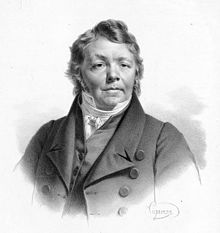Johann Nepomuk Hummel's Piano Sonata No. 5 in F-sharp minor, Op. 81 was written and published in 1819.[1] The work is written in a proto-Romantic style that anticipates the later stylistic developments of composers such as Frédéric Chopin, Franz Liszt, Robert Schumann, Charles-Valentin Alkan, Felix Mendelssohn, and Johannes Brahms.
| Piano Sonata No. 5 | |
|---|---|
| by Johann Nepomuk Hummel | |
 Hummel in 1820 | |
| Key | F-sharp minor |
| Opus | 81 |
| Composed | 1819 |
| Dedication | Princess Marie of Saxe-Weimar-Eisenach |
| Published | 1819 |
| Publisher | Steiner |
| Duration | 23-35 minutes |
| Movements | 3 |
| Scoring | piano |
Structure
editThis sonata has three movements:
- I. Allegro
- II. Largo con molto espressione (in B minor)
- III. Finale:Vivace
The first movement is in sonata form. The movement has been described as a "stylistic mélange of writing that more closely resembles a fantasy than a formally structured sonata first movement (there is no exposition repeat, for example)."[2]
The second movement, marked Largo con molto espressione, is in B minor and 3/4 time.
The finale is in rondo form and returns to the sonata's home key of F-sharp minor. It is the most technically challenging movement, featuring double thirds and fugal passages.
Reception and influence
editThis sonata influenced certain works of Schumann, Chopin, and Brahms.
Joel Lester points out the similarities between this sonata and Schumann's Allegro Op. 8 and Piano Sonata No. 1 in F-sharp minor, Op. 11.[3] Schumann said that the work will "alone immortalize his [Hummel's] name."[4]
Chopin based his Piano Sonata No. 3 on this sonata.[5]
This sonata may also have influenced Brahms' Piano Sonata No. 2 in F-sharp minor, Op. 2.[6]
References
edit- ^ "Hummel Piano Sonatas". Gramophone. Retrieved 2024-03-04.
- ^ Nicholas, Jeremy. "Piano Sonata in F sharp minor, Op 81". Hyperion. Hyperion.
- ^ Lester, Joel (1995). "Robert Schumann and Sonata Forms". 19th Century Music. 8 (3): 189–210.
- ^ Kroll, Mark (2007). Johann Nepomuk Hummel A Musician's Life and World. Scarecrow Press. p. 276.
- ^ Rosen, Charles (1998). Sonata Forms. p. 390.
- ^ Carew, Derek (2005). "Hummel's Op. 81: a paradigm for Brahms' Op.2?". Ad Parnassum. 3 (6): 133–156.